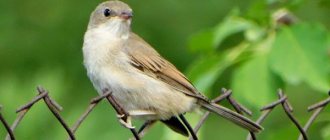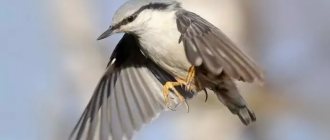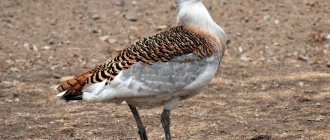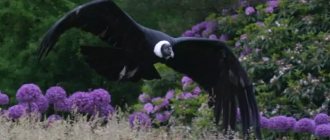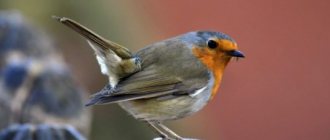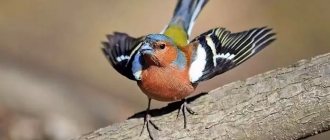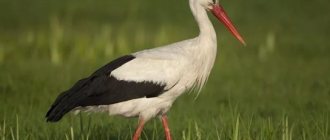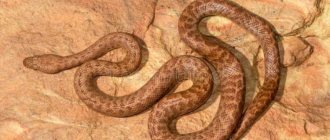| Latin name: | Sylvia |
| English name: | garden warbler |
| Kingdom: | Animals |
| Type: | Chordata |
| Class: | Birds |
| Squad: | Passeriformes |
| Family: | Slavaceae |
| Genus: | Warblers |
| Body length: | 15 cm |
| Wing length: | 8 cm |
| Wingspan: | 17 cm |
| Weight: | 20 g |
- 7.1 Cage requirement
- 8.1 Food for warblers
Poultry nutritional features
— Advertising —
Warblers are omnivorous birds. In summer, they willingly eat insects, for example, mosquitoes, caterpillars, dragonflies, and flies. In autumn and winter, warblers turn their attention to plant food - plant seeds and berries.
The short and tenacious beak of warblers allows them to easily and conveniently obtain both animal and plant food.
Subspecies
There are 4 subspecies:
- Sylvia communis communis: Western Europe, from Scandinavia to North Africa; winters in northern Africa.
- Sylvia communis volgensis from Eastern Europe to Western Siberia.
- Sylvia communis icterops: Western Siberia, Iran, Asia Minor; winters in eastern Africa.
- Sylvia communis rubicola: northeastern China, Mongolia and Kazakhstan; winters in South Africa.
Bird species
Atlas Warbler
It lives in northwestern Africa and southern Europe in subtropical and tropical forests. Prefers to nest at an altitude of 1000 to 2500 meters above sea level. Flies to Morocco for the winter. The body length of birds is 12-14 cm; wingspan up to 17 cm.
African Desert Warbler
Body length is up to 12 cm, weight is about 10 g. Females and males do not differ from each other; they have a brown back and a white belly. The beak and legs are yellow. The species is widespread in Africa and does not migrate.
White-whiskered Warbler
Males have a dark gray back, a pink belly, a tail decorated with white stripes, and also white stripes running down from the corners of the beak, which is how the species got its name. Females and young animals are grayish-brown in color with a white belly. The bird lives in Turkey and the Caucasus. Winters off the coast of the Red Sea.
mountain warbler
A small bird about 14 cm in length, weighing up to 17 g. It lives in tropical and subtropical forests of Asia at altitudes of 2000 - 3000 m above sea level (Kazakhstan, Afghanistan, Iran, Pakistan, Turkmenistan). Winters in southern India and Sri Lanka.
Yemen Tit Warbler
Endangered. It lives in Yemen and Saudi Arabia, in tropical and subtropical forests. The body length of this species reaches 15 cm.
Spectacled Warbler
A resident of Europe, the spectacled warbler resembles the gray warbler in appearance. Its size is from 12 to 14 cm, body weight is up to 10 g. The bird’s head is gray, its throat is white, its back is brown, and its chest and belly are pinkish-gray. The plumage on the wings is red-brown.
Warbler
This species has a black cap on its head. The back is brown, the belly is white. The species is found in Asia and southern Europe.
Pied Warbler
Lives in the arid savannas of Asia at altitudes from 250 to 2000 meters above sea level. The average body length is about 16 cm. The characteristic cry of “chuck” is heard in the song.
Provençal Warbler
Body length is from 10 to 15 cm. The upper part of the body is gray, the bottom is red. The female is a little lighter. The species is found in southern Europe.
Desert Warbler
The habitat of the species is Asia and northern Africa. Body length is about 12 cm. The plumage on top is yellowish-gray, the belly is white with rufous, the tail is with white stripes. The beak is thin and yellow. Sexual dimorphism is not expressed.
garden warbler
A resident of Europe and Western Siberia with a body length of 13-15 cm, weight up to 22 g. The plumage of the garden warbler is gray-brown, monochromatic, with a greenish tint. The chest, belly and undertail are white. Males and females do not differ in color, the young are slightly lighter.
Sardinian Warbler
The species is distributed in southern Europe. This is a small bird with a large beak, reminiscent of the Provençal warbler. The back is gray, the belly is brick-red. Adult males have dark spots on their foreheads. The legs are painted red.
Gray Warbler
A small nimble bird the size of a sparrow. Her back is gray-brown with red, her head and sides are ashen; throat – white; The tummy is painted a delicate pink color. The species is distributed in Europe, Asia, Western Siberia, northern Africa, and also in Israel.
Rüppel's Warbler
Lives in Greece and Turkey. It is a small gray bird with black wings and a black tail decorated with white feathers.
Whitethroat or Miller's Warbler
Distributed in Central Europe. Body length - up to 14 cm, wing length - about 7 cm; body weight 12 – 15 g. Colored brown. This species is very similar to the gray warbler, but is slightly smaller in size and has a dark stripe on its head.
Mediterranean or oil warbler
The species is common in Spain and Italy. Body length is up to 14 cm. Birds have pronounced sexual dimorphism. Males are dark gray above with a black head and gray belly, the eye ring is red. Females have a gray head plumage, a brown back, and gray-brown sides.
Subalpine or rufous-breasted warbler
The species is found in the Mediterranean. Body length – 12-13 cm. The back is intensely gray, the belly is a little lighter. Birds have a characteristic white stripe on their chest.
Black-headed Warbler
The species lives throughout Europe and northern Africa. Body length – up to 15 cm, wingspan about 16 cm; weight - up to 22 g. The color of the plumage is brown-gray with a light belly. Males wear a black “cap” of feathers on their heads, and females wear a red one.
Hawk's Warbler
Lives in Europe. It is the largest species with a body length of up to 18 cm; weighing about 30 g. The back is grayish-green, the head is dark. The rump is colored black and white. The belly is white with a brown pattern, which is similar to the color of the chest of a hawk.
Interesting Facts
- Among the warblers there are birds that have the ability to sew. These are tailor warblers. Birds sew leaves together when they make nests. Threads are pulled from cobwebs, plant fluff or cotton fibers. They pierce the leaves with a sharp beak and insert a thread there. In this way they fasten the leaves on both sides, sewing one to the other. The result is a bag, which becomes the nest of a skillful bird. The most amazing thing is that this work is performed by a male.
- Warblers are very tireless birds. When flying away for the winter, they are able to fly hundreds of kilometers without stopping to rest. Therefore, they prepare seriously for the flight, gaining muscle mass and fat reserves in advance.
- Warblers are close relatives of mockingbirds, so they tend to “copy” the singing of other birds, such as the robin, nightingale, songbird and blackbird. You get one bird at home, but you get a whole “singing set”.
- Male warblers almost stop singing after nesting. Apparently, they put too much effort into attracting a girlfriend.
Warblers at home
Small, agile warblers do well in captivity. If the bird was recently caught, it may initially behave restlessly and bang against the cage. In such cases, cover the cage with a cloth and try not to disturb the bird. Within a few days, warblers usually get used to people, and even begin to recognize the owner and greet his appearance with ringing singing.
The character of warblers is calm and very peaceful. Birds of other species can show aggression towards them and offend warblers, so it is better to house them separately.
Cage requirement
A spacious aviary or a rectangular cage located away from drafts is suitable for keeping warblers. The room temperature should not fall below 18-20 °C, as these birds love warmth. The cage must contain perches, a feeder, a drinking bowl and a bathing container. Disinfect the cage once a month.
Character and lifestyle
All species of warblers are mobile; they do not accept a sedentary lifestyle. One can only envy these birds for their agility and agility. Moreover, warblers behave nimbly on any terrain, and even dense thickets do not interfere with their mobility. In addition to the fact that warblers move beautifully, they are also excellent singers.
It should be noted that many warblers differ little in appearance, but their voices are different. Some warblers chirp, and their song resembles the sounds of a flute, while other voices sound abrupt and rhythmic.
In addition to the fact that warblers move beautifully, they are also excellent singers. It should be noted that many warblers differ little in appearance, but their voices are different.
Listen to the voice of the warbler bird
Listen to the singing of the Black-headed Warbler
Some warblers chirp, and their song resembles the sounds of a flute, while other voices sound abrupt and rhythmic. In general, the singing of the warbler bird indefinitely. That is why this type of bird is often kept in houses, because nothing compares to their whimsical singing, which will be heard by the inhabitants of the house in the morning.
Warblers are also very smart. These birds know how to choose friends from those around them and stay away from enemies. At the moment of pursuit, they can skillfully evade pursuit.
There is interesting information about the migration of warblers to warmer regions. They fly at night. There is an opinion that they follow night routes using a navigator, which for them is the polar star. Ornithologists also noticed that adult birds are the first to rush to nesting sites.
Breeding warblers
In captivity, warblers also form pairs and begin nesting. To do this, it is necessary to plant plants in a cage or aviary so that the birds can build a nest for themselves.
At one time, the female lays from 4 to 8 eggs, which are incubated by both parents in turn. After two weeks, the chicks are born.
Food for warblers
The main food for warblers is various grain mixtures, pieces of fruits and vegetables, and berries (blueberries, raspberries, elderberries, currants). During nesting, their diet is enriched with animal food - insects, mealworms, ant eggs.
Reproduction and lifespan
Nesting for warblers returning from the winter begins in our latitudes at the end of April. As soon as the warblers arrive in their native places, they settle in the territory where they will build nests and begin to sing their wonderful melodies.
At such moments, the males’ songs mean that the place has already been taken, and the trills also sound like the female’s call for mating. It should be noted that warblers have a well-organized family life; they are both faithful spouses and caring parents. After the pairs are created, the birds begin to build nests together.
Typically, warbler nests are made in the crown of trees at a height of 1.5-2.0 meters above the ground. The bedding is the hairs of domestic animals, such as horses, cows, as well as moss, dry leaves and other pasture material.
The female incubates the eggs for two weeks. After the chicks appear, the sympathetic mother does not leave the nest for two or three days; after the specified time, she and the father of the family fly away in search of food. A married pair of warblers continues to feed the young that have fluttered out of the nest for another third of the month, but soon they begin a new clutch and everything repeats.
The life cycle of warblers in the wild is 7-10 years, and with good home care, these birds can delight their owners with their singing for 10-12 years, which by bird standards is not so little.
Nesting period
Forests and city parks become habitats for birds. Watching birds is a fascinating process. Having returned from the winter hut, the blackhead begins to arrange nests. The male is engaged in construction, erecting several options for the female to choose from.
- garden dormouse
Males build nests at a height of 2-3 meters. Reproduction features allow birds to breed several offspring per season. The warbler lays up to 5 eggs at a time.
Both partners do the incubation. The chicks are born two weeks later. Both males and females feed the young for 21 days.
Number
One of the most common warblers in the world. The range is extremely extensive. Although bird numbers are slowly declining, the decline is not considered fast enough to approach the vulnerability threshold. Globally, the trend shows a moderate decline in population size. However, Europe has seen a modest increase in bird numbers since 1980, based on preliminary data from 21 countries on the continent included in the overall bird-watching scheme. This distances the bird from the threshold of vulnerability, and the species is considered non-threatened based on range and abundance criteria. The species' population in Europe is estimated at 14–25 million breeding pairs, representing between 50 and 74% of the global population. In Ukraine - 1.46-1.9 million pairs, in Bulgaria - from 70,000 to 200,000 breeding pairs, in Serbia - 81,000-105,000 pairs. The population is distributed unevenly; there can be up to a dozen pairs in an area of 1 km2. According to initial monitoring data of common bird species, this species has a strong growth trend as in Europe. The global population in 2001 was estimated to be between 57 and 150 million birds. However, according to recent data, the number is declining.
Description
All these small, agile and nimble birds are very similar to each other. Their plumage is dominated by gray and brown shades, with the addition of black and white. Only a few species are marked with red or pinkish plumage. On average, the size of warblers does not exceed the size of an ordinary sparrow. Their body length is up to 15 cm; wingspan is about 17 cm, weight – up to 20 g.
In some species of warblers, males are colored differently than females.
Notes
- ↑ Boehme R.L., Flint V.E.
Five-language dictionary of animal names. Birds. Latin, Russian, English, German, French / Under general. ed. acad. V. E. Sokolova. - M.: Russian language, RUSSO, 1994. - P. 343-344. — 2030 copies. — ISBN 5-200-00643-0.
This page was last edited on July 1, 2022 at 11:25 am. Sources used:
- https://bioros.net/ptitsy/sadovaya-slavka.html
- https://gurkov2n.jimdofree.com/birds/passeriformes/garden warbler/
- https://www.ebirds.ru/vid/333.htm
- https://wiki2.org/ru/warblers
Singing
The song is fast, with a "squeaky" sound consisting of three descending tones. The sounds vaguely resemble “tir-li-vi-tir-li-chet-chit-chitirli”, and the alarm signal is a short, loud and ringing “check”. The beginning of the song is quiet, but the end is loud and abrupt. Like most warblers, it quickly perceives the chirping of other species and imitates it with pleasure. In its songs you can recognize the trills of the great tit, black-headed goldfinch or linnet. Unlike other species of warblers, the gray warbler also sings while flying.
